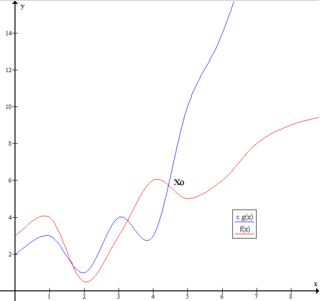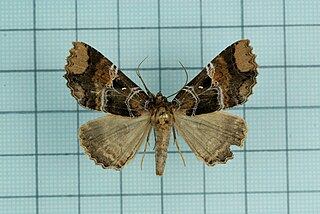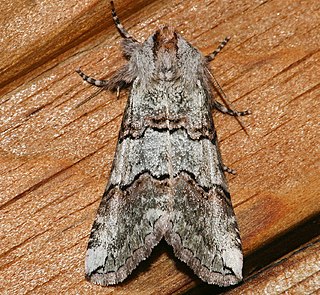
In mathematics, convolution is a mathematical operation on two functions that produces a third function that expresses how the shape of one is modified by the other. The term convolution refers to both the result function and to the process of computing it. It is defined as the integral of the product of the two functions after one is reversed and shifted. The integral is evaluated for all values of shift, producing the convolution function.

The International Phonetic Alphabet (IPA) is an alphabetic system of phonetic notation based primarily on the Latin script. It was devised by the International Phonetic Association in the late 19th century as a standardized representation of speech sounds in written form. The IPA is used by lexicographers, foreign language students and teachers, linguists, speech–language pathologists, singers, actors, constructed language creators and translators.

Big O notation is a mathematical notation that describes the limiting behavior of a function when the argument tends towards a particular value or infinity. Big O is a member of a family of notations invented by Paul Bachmann, Edmund Landau, and others, collectively called Bachmann–Landau notation or asymptotic notation. The letter O was chosen by Bachmann to stand for Ordnung, meaning the order of approximation.

A Fourier transform (FT) is a mathematical transform that decomposes functions depending on space or time into functions depending on spatial frequency or temporal frequency. An example application would be decomposing the waveform of a musical chord into terms of the intensity of its constituent pitches. The term Fourier transform refers to both the frequency domain representation and the mathematical operation that associates the frequency domain representation to a function of space or time.

Christopher George Latore Wallace, better known by his stage names the Notorious B.I.G., Biggie Smalls, or simply Biggie, was an American rapper and songwriter. Rooted in the New York rap scene and gangsta rap traditions, he is widely considered one of the greatest rappers of all time. Wallace became known for his distinctive laid-back lyrical delivery, offsetting the lyrics' often grim content. His music was often semi-autobiographical, telling of hardship and criminality, but also of debauchery and celebration.

In thermodynamics, the Gibbs free energy is a thermodynamic potential that can be used to calculate the maximum work that may be performed by a thermodynamically closed system at constant temperature and pressure. It also provides a necessary condition for processes such as chemical reactions that may occur under these conditions.

The Thyatirinae, or false owlet moths, are a subfamily of the moth family Drepanidae with about 200 species described. Until recently, most classifications treated this group as a separate family called Thyatiridae.

Tongeia is a Palearctic genus of butterflies in the family Lycaenidae found in temperate East Asia. Most species are endemic to China and many species are recently described from China. The best known species is the more widely distributed Tongeia fischeri.

Sypnoides is a genus of moths in the family Erebidae.

In telecommunications, 5G is the fifth-generation technology standard for broadband cellular networks, which cellular phone companies began deploying worldwide in 2019, and is the planned successor to the 4G networks which provide connectivity to most current cellphones. 5G networks are predicted to have more than 1.7 billion subscribers worldwide by 2025, according to the GSM Association.
Ceranemota albertae, the Alberta lutestring, is a species of moth of the family Drepanidae first described by John Frederick Gates Clarke in 1938. It is found in western Canada, from south-central British Columbia east to south-eastern Saskatchewan. The habitat consists of dry open woodlands and shrub areas with wild cherry.

Rebbeca Marie Gomez, known professionally as Becky G, is an American singer and actress. She first gained recognition in 2011 when she began posting videos of herself covering popular songs online. One of her videos caught the attention of producer Dr. Luke, who subsequently offered her a joint record deal with Kemosabe Records and RCA Records. While working on her debut effort, Gomez collaborated with artists will.i.am, Cody Simpson and Cher Lloyd. Her official debut single, "Becky from the Block" (2013), received a positive reception upon its release. She released her debut extended play, Play It Again (2013), later that same year. Her second single, "Can't Get Enough" (2014), featured guest vocals from Pitbull and went on to top the Latin Rhythm Airplay chart in the United States.

Ceranemota is a genus of moths belonging to the subfamily Thyatirinae of the Drepanidae.

Ceranemota improvisa is a moth in the family Drepanidae. It was described by Henry Edwards in 1873. It is found in North America, where it has been recorded from northern California, western Oregon, western Washington and south-western British Columbia. Adults are on wing from late September to November in one generation per year.

Ceranemota fasciata is a moth in the family Drepanidae. It was described by William Barnes and James Halliday McDunnough in 1910. It is found in North America, where it has been recorded from British Columbia to northern California. It is also present in coastal southern Alaska. The habitat consists of coastal rainforests, mixed hardwood forests and montane riparian areas.

Ceranemota crumbi is a moth in the family Drepanidae. It was described by Foster Hendrickson Benjamin in 1938. It is found in North America, where it has been recorded from western Oregon and the Washington Cascade Range. The habitat consists of coastal rainforests and mixed hardwood forests.
Ceranemota semifasciata is a moth in the family Drepanidae. It was described by Foster Hendrickson Benjamin in 1938. It is found in North America, where it has been recorded from northern California.

Ceranemota tearlei is a moth in the family Drepanidae. It was described by Henry Edwards in 1888. It is found in North America, where it has been recorded from British Columbia and central Alberta south to central California in the west and to Utah and Colorado in the Rocky Mountains. The habitat consists of higher elevation spruce-fir and mixed hardwood-conifer forests, lower elevation ponderosa pine forests, quaking aspen forests and moist riparian areas along creeks and rivers.
Ceranemota partida is a moth in the family Drepanidae. It was described by John Frederick Gates Clarke in 1938. It is found in North America, where it has been recorded from northern Colorado.













